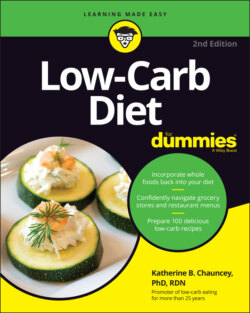Читать книгу Low-Carb Diet For Dummies - Katherine B. Chauncey - Страница 102
Evaluating it
ОглавлениеAfter you have a record of what you’ve eaten, you need to evaluate how healthy it is. To determine the number of servings you consumed, you’ll need to estimate portion sizes. You’ll be surprised to see that normal portion sizes are a lot smaller than you think. Here are some examples:
| Portion | Approximate Size |
|---|---|
| ½ cup | About the size of a woman’s tight fist, or a tennis or billiard ball |
| 1 medium fruit | About the size of a man’s tight fist |
| 1 medium potato | About the size of a computer mouse |
| 1 ounce cheese | About the size of your thumb |
| 3 ounces meat | About the size of the palm of a woman’s hand or a deck of cards |
| 1 cup | A standard 8-ounce measuring cup |
To assess your diet, follow these steps:
1 Look for the basic foods known to be essential in a healthy diet.Calculate your average daily intake by taking your totals and dividing them by the number of days you kept your food record. For example, if you’ve tallied seven fruits over a four-day period, you’ve consumed an average of 1.75 pieces of fruit each day (7 ÷ 4 = 1.75).Use a chart like Table 4-4 to track what you eat.TABLE 4-4 Recording What You EatFoodsRecommended Daily ServingsNumber of Servings You ConsumedFruitMedium piece or ½ cup2Vegetables, non-starchy½ cup3Starchy vegetables½ cup3Breads or cereals1 slice or ½ cup2Whole-grain breads or cereals1 slice or ½ cup3Lean meats, poultry, or fish3 ounces2Egg or cheese, low-fat*1 ounce*1Milk (skim, ½%, 1%) or yogurt1 cup2Water or other Nonsweetened beverage1 cup8* You don’t need foods from this category every day.
2 Look for extra foods that contribute calories but don’t contribute significant nutrients.There are no recommended servings in this category so you just need to record your daily intake. Be honest in this assessment. Research indicates that the Western diet can contain more than 50 percent of refined and processed foods. These foods count as carbs and provide calories, sugar, and fat, but no significant nutrients.Use Table 4-5 to record your intake.TABLE 4-5 Recording Your Refined and Processed FoodsServing SizesNumber You ConsumedChips, 1-ounce snack sizeCookiesDessert, cake, pie, pudding, ½ cup or 1 pieceIce cream or other frozen desserts, ½ cupSoft drink, regular, 8 ouncesMeals away from homeFast-food mealsHamburgerCheeseburgerFried fish or fried chickenBurritos or tacosFrench fries, regular sizePizza, 1 medium sliceBiscuits, 1 mediumRolls, 1 mediumGravy, ¼ cup
3 Answer the following questions about your food intake:Did you meet the minimum servings for the basic foods in Step 1?Did your intake of the foods in Step 2 equal or exceed your intake of the foods in Step 1?Can you replace some of your Step 2 choices with Step 1 choices?Are you starting to get the picture of your food habits?Step 2 food choices are okay if you’re meeting your intake of the basic food groups and if your weight is in the normal range. If you’re physically active, you can handle more Step 2 foods than people who aren’t very active.
